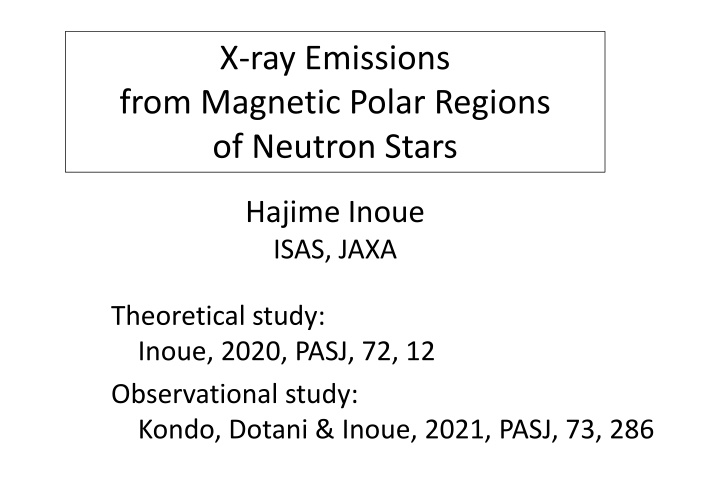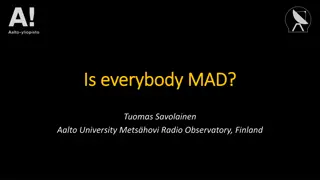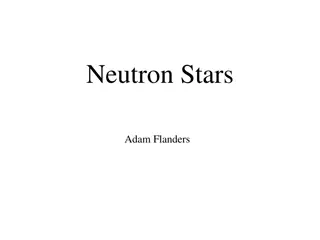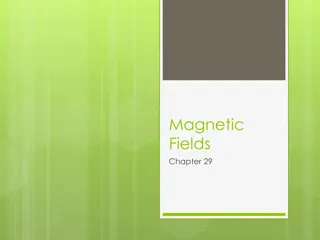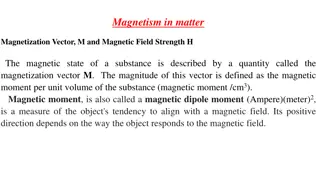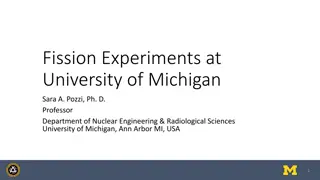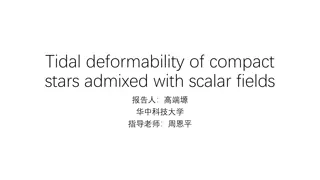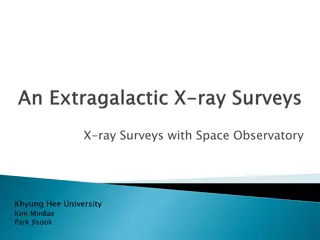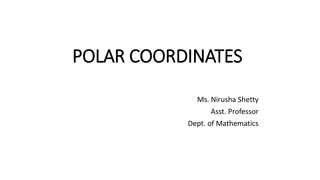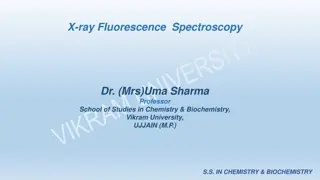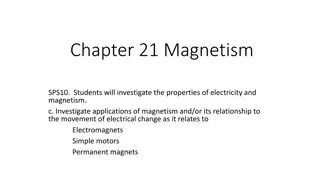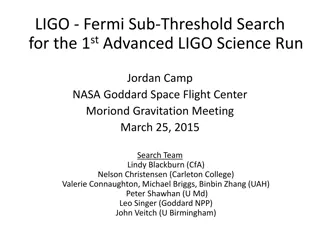X-ray Emissions from Magnetic Polar Regions of Neutron Stars - A Study
Investigate the X-ray emissions originating from the magnetic polar regions of neutron stars through theoretical and observational studies conducted by Hajime Inoue and collaborators. The theoretical study by Inoue (2020) published in PASJ provides insights, while the observational study by Kondo, Dotani, & Inoue (2021) offers valuable observations. Delve into the intriguing phenomena surrounding these compact celestial bodies and explore the implications of these findings.
Download Presentation

Please find below an Image/Link to download the presentation.
The content on the website is provided AS IS for your information and personal use only. It may not be sold, licensed, or shared on other websites without obtaining consent from the author.If you encounter any issues during the download, it is possible that the publisher has removed the file from their server.
You are allowed to download the files provided on this website for personal or commercial use, subject to the condition that they are used lawfully. All files are the property of their respective owners.
The content on the website is provided AS IS for your information and personal use only. It may not be sold, licensed, or shared on other websites without obtaining consent from the author.
E N D
Presentation Transcript
X-ray Emissions from Magnetic Polar Regions of Neutron Stars Hajime Inoue ISAS, JAXA Theoretical study: Inoue, 2020, PASJ, 72, 12 Observational study: Kondo, Dotani & Inoue, 2021, PASJ, 73, 286
Since discoveries of Cen X-3 (Giacconi et al. 1971) with Uhuru, more than 100 X-ray pulsars have been found. General consensus on situations of X-ray pulsars a close binary of a strongly magnetized neutron star + a normal star an accretion flow from the normal star to the neutron star a magneto-boundary surface at ~ 108cm where the magnetic pressure of the NS once stops the flow two channeled flows along magnetic funnels to the magnetic poles at the NS surface X-ray emissions from the polar regions at the NS surface an oblique rotation of the magnetic axis, causing X-ray pulsation
Theoretical study : Structures of X-ray emitting magnetic polar regions on neutron stars (Inoue, 2020, PASJ, 72, 12) Basic consideration: Accreted matter accumulates in a polar cone on a neutron star. Hydrostatic equation: ?? ??= ??? ?,?: pressure & density ?,?: mass & radius of N.S. ?2, when ?, ??? and we get ? = ??? ? ?2 , where ? = 0 ? : Pressure at the bottom of the polar cone ? : Column density along the z-axis in the polar cone As the accumulation proceeds, ? increases and ? increases. When ? exceeds the magnetic pressure of the magnetic funnel, the matter in the polar cone is likely to flow out from the bottom of the polar cone and to form a polar mound by dragging the magnetic lines of force. shock Polar Cone Region Hence, we can expect ? ? 2 8? . Polar Mound Region ? 2 8? ?? ?2 , The column density, ??, is given as ?? and can be approximated to be constant independent of the accretion rate, ?.
Since the polar cone is optically thick, the radiation energy also accumulates there in the photon diffusion time. When > ??, the photon diffusion time, ??, is approximately given as ?? 3??????2 4? . ??: the average radius of the polar cone ??: the average density of the polar cone ??: the Thomson scattering opacity ?: the velocity of light ? On the other hand, the matter accumulation time, ??, is written as ?? ?????2 ? 2 ? 2 . =?? ???2 ( ? is the total accretion rate to the N.S. and the factor 1/2 comes from the assumption that the accretion flow is evenly divided into the two funnel flows to the magnetic N and S poles.) shock ??= ?? . In the steady state, 3?? ? ? = 1.4 x 105 1017g/s cm Polar Cone Region 8? ?? The height of the polar cone, , is expected to increase as the accretion rate, ?, increases, and to become comparable to or even larger than the stellar radius when ? approaches to 1018g/s. Polar Mound Region
More generalized calculation is done for the structure of the polar cone by Inoue (2020). The height of the polar cone When ? is 1018g/s, the height, , is close to 10 times the N.S. radius, ?.
Expected X-ray emission 3 components ?? = 4 ? ? : Luminosity from the surface of the polar cone ? : Specific energy density at the center of the polar cone ?? 3 ? I) 2 components from the Polar Cone: ? ? ? Top region 3 x 1017g/s 3 x 1016g/s (1) 3 x 1018g/s specific eregy density ??/?) Bottom region (3) (2) ( Top region Bottom region Mound Portions of the radiated energy of the 3 components 1 (3) (1) (1) X-rays from a region near the top boundary The release of the kinetic energy before reaching the shock. (2) (2) X-rays from a region near the bottom boundary 10-1 The release of the gravitational energy due to the gradual infall of the matter in the polar cone. II) 1 component from the Polar Mound (3) X-rays from the Polar Mound The release of the remaining radiation-energy at the bottom of the polar cone. 10-2 1016 1017 1019 1018 ? ( g/s )
Two typical cases of accretion rate Portions of 3 emission components Height of the Polar Cone 1 (PC-Top) 100 (Mound) (PC-Bottom) 10 hS/R 10-1 1 0.1 10-2 1016 1017 1019 1018 1016 1019 1017 1018 ? ( g/s ) ? ( g/s ) Case of low accretion rate : ? 1016g/s Case of high accretion rate : ? 1018g/s Emission from a region behind the shock Quasi-single blackbody emission Multi-color blackbody emission Becker & Wolff (2007)
Expected X-ray spectrum Bright X-ray pulsars L 1037 1038erg/s ? 1017 1018g/s 2 component spectrum a multi-color blackbody + a blackbody (Mihara 1995; Makishima et al. 1999) "NPEX" model well reproduces observed spectra of several X-ray pulsars. NPEX model FE ? ??) (AnE- + ApE2) exp(- E- exp(- ? ??) multi-color blackbody spectrum ?? = 4 ? ??PC r- 3 T = 2 r Te4 r = 6 2( + ) + +1 E Te r-( + +1)/4 ? ??) single blackbody spectrum E2exp(- FE The 2-component spectrum of a multicolor blackbody + a blackbody well reproduces Her X-1 spectra in every pulse phases by changing only normalization factors. (Kondo, Dotani & Inoue 2021) E
Observational study : Studies of emission regions of the X-ray pulsar Hercules X-1 with pulse- phase-resolved spectra observed with Suzaku (Kondo, Dotani & Inoue 2021) Analyzed data Suzaku data of Her X-1 during the main-on phase of the 35 day cycle on 2008 February 21.
Ratio spectra Hypothesis of the analysis: B/E A/E Observed periodic variations of the continuum spectra: Due to changes of the projection areas of the emission regions viewed from the observer H M L No associated change of the spectral shape observed from each of the emission region C/E D/E Search for flat portions in the ratio spectra Three candidate energy-ranges are found. Low energy range : 0.3 - 1 keV Medium energy range : 2 - 6 keV High energy range : 18 - 30 keV ?2 tests of the flatness approve Low energy component common to all A - E phases Medium energy component common to all A - E phases High energy component common to A - B phases common to C - E phases B/A
Solving the simultaneous equations for the intrinsic spectral components from a pair of the phase-resolved spectra that show flat portions in the ratio spectrum. Low energy component a soft blackbody Medium energy component a cut-off power law High energy component a hard blackbody Final simultaneous fit to all the phase-resolved spectra with a composite model of three continuum components together with a cyclotron absorption feature and an iron line. Acceptable result Phase B Phase A Phase C Phase D Phase E
Best fitting parameters of the revised three-continuum component model The revised three-continuum component model : the cut-off power law model the modified multicolor blackbody model for the medium energy component
Discussions on the fitting results Hard b-body Same flux-peak-phase of the hard b-body component and the multi-color b-body component M-color b-body Phase 3 components in the beam pattern discussed by Inoue (2020) (2) I) 2 components from the Polar Cone region 1) a narrow pencil beam : Main peak of the M-Color BB Comp. 2) a broad fan beam II) 1 component from the Polar Mound region (1) (3) 3) a broad pencil beam : Main peak of the Hard BB Comp. X-ray beaming in the direction of the magnetic lines of force (Basko & Sunyaev 1975) free from electron scattering X-rays originally polarized along the field lines tends to be beamed in the direction of the lines of force. X-rays polarized along the lines of force free from electron scattering X-rays polarized perpendicular to the lines of force X-rays originally polarized perpendicular to the lines of force should be emitted without beaming. central side of the Polar Cone magnetic lines of force in the surface layer of the Polar Cone
Deferences of the best fit parameter-values in the hard blackbody component between the phases A-B and the phases C-E. BB temperature Cyclotron energy A possible interpretation : We see different polar mounds at the opposite magnetic poles. A - B phases C - E phases side view Observer Observer Hard blackbody component + Cyclotron absorption Polar mound
Presence of phase-dependent obscuration complications in reproduction of the pulse profiles Pulse profile variation of Her X-1 associated with the 35-day cycle Main on Mid on Accretion flow along the magnetic funnels could be optically thick and possible to periodically obscure the central X-ray source. Candidate place of the soft blackbody component observer This funnel pattern could change in association with the 35-day cycle. (Scott et al. 2000)
Summary I studied structures and properties of an X-ray emitting magnetic polar region on a neutron star composing of a polar cone region and a polar mound region. (Inoue 2020, PASJ, 72, 12) This model can well reproduce the pulse-phase-resolved spectra of Her X-1 observed with Suzaku. (Kondo, Dotani & Inoue 2021, PASJ, 73, 286) shock Polar Cone Region Multi-color blackbody emission Polar Mound Region Quasi-single blackbody emission + Cyclotron absorption
